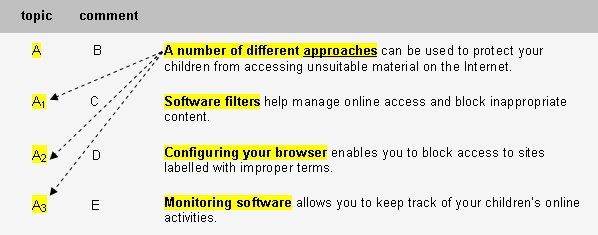|
FOUR PATTERNS OF TOPICAL PROGRESSION Pattern 1: CONSTANT TOPIC
Here, the writer uses the same topic in a series of sentences.
Often, the actual word(s) used in the topic of the first sentence may be repeated using identical wording
or reduced wording 
Reprinted from Journal Of Materials Processing Technology, Vol 137, Blazdell P, Solid free-forming of ceramics using a continuous jet printer, pp 52-53, Copyright (2003), with permission from Elsevier Pattern 2: PROGRESSIVE TOPIC In this pattern, an element of the comment of the previous sentence becomes the topic of the next. Sometimes, the actual word(s) used in the comment of the first sentence may be repeated in the topic of a later sentence, or a synonym or closely related word or phrase may be used. This pattern allows the writer to form 'bridges' between parts of the text, while the message develops in a logical way. This pattern is the second most common of the four. 
Reprinted from International Journal of Heat and Fluid Flow, Vol 24, Naylor D, Recent developments in the measurement of convective heat transfer rates by laser interferometry, p 347, Copyright (2003), with permission from Elsevier. Pattern 3: HYPERTOPIC In this pattern, the first sentence introduces a general topic, the 'hypertopic', using a superordinate term. The topics of the following sentences form sub-topics (e.g., car, bicycle, train, bus) of the hypertopic (e.g., vehicle). Often, the relationship of the sub-topics to the hypertopic is common general knowledge, but other times the relationship between these may be understood only by expert readers in a particular field. 
Pattern 4: SPLIT TOPIC In this pattern, two or more elements of the 'comment' in the first sentence are picked up as the topics of the following sentences. Sometimes, the actual word(s) used in the comment of the first sentence may be repeated using identical wording or reduced wording in the 'split topics' that follow, though a synonym may also sometimes be used. 
Reprinted from International Journal of Heat and Fluid Flow, Vol 24, Naylor D, Recent developments in the measurement of convective heat transfer rates by laser interferometry, p 347, Copyright (2003), with permission from Elsevier. Click the 'exercise' button below to check your understanding of the four patterns, or 'next' to continue with the module.
|
| Finnish Virtual University / © 2004 McAnsh, Paganuzzi & Pennington |